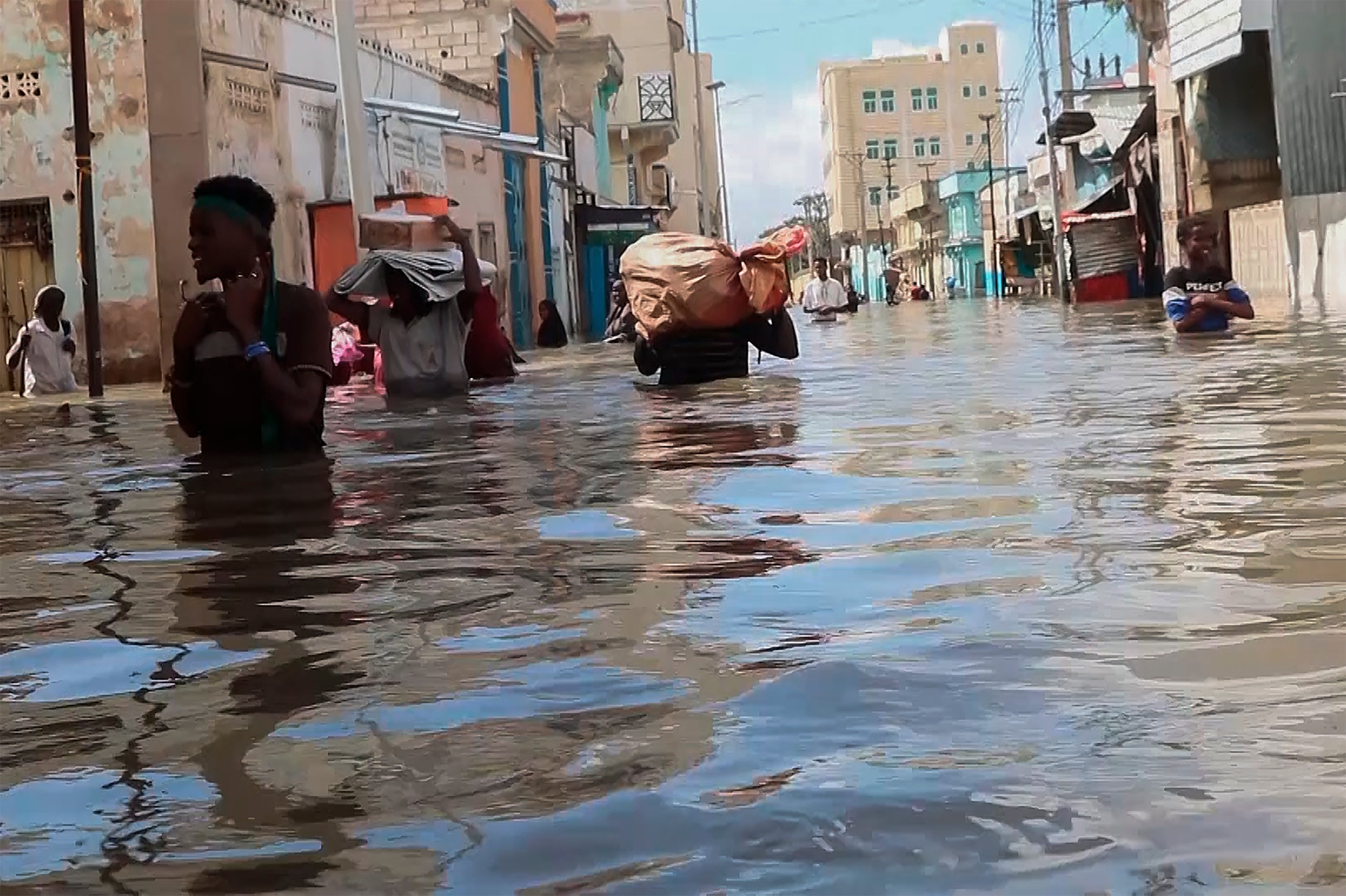The world is experiencing record temperatures – this is why it’s about to get worse
April 1, 2025
The landmark 2015 Paris Climate Agreement was supposed to be a turning point in the fight against global warming. The historic treaty saw nearly 200 countries commit to limit increases in temperature to 1.5C above pre-industrial levels.
Yet in 2024, the global average temperature was already up by 1.6C, shattering the recommended ceiling in less than a decade, and increasing the risks of extreme weather events, drought, wildfires and the devastation of crops.
By the end of the century, this could rise to a devastating 3.1C of warming above pre-industrial levels, even when implementing current climate policies, say the UN.
Climate scientists have shown that humans are responsible for the majority of global heating over the last two centuries, broadly since the industrial revolution. But the Paris accords are under pressure, not least from Donald Trump, who has withdrawn the US from the agreement for a second time, while touting the benefits of ‘drill, baby, drill” to boost oil and gas production. Argentina’s President Javier Milei has called global warming a “socialist lie”.
Nearly 95 per cent of countries missed the UN deadline to submit new climate pledges for 2035, according to Carbon Brief, with just 13 member parties of the Paris Agreement publishing plans to cut emissions by 10 February this year (ironically including the US with the plans agreed under the Biden administration).
In 2023, at least $3.1 billion dollars of US foreign aid was allocated for projects relating to climate action, amounting to 1,406 separate activities, according to foreign assistance data.

The Untied States’ environmental aid included a $1 billion USAID contribution to the Green Climate Fund, a UN vehicle for funding sustainable projects in developing countries, under the Biden administration. Yet since coming into office, President Trump has rescinded $4 billion in pledges to the fund, and gutted aid funding which contributed to environmental projects worldwide.
Climate-related projects are some of the most likely to be in the firing line, warns Ed Carr, former USAID and World Bank adviser.
“If you’re an organization that is working on projects that are clearly focused on climate change, your project is probably in trouble,” Mr Carr told Devex in January.
Conservation projects in Colombia lost $70 million worth of funding, which environment minister Susana Muhamad said will primarily impact the Amazon rainforest.

And an unclear future for US-funded protection of endangered species in Kenya, Indonesia and worldwide puts orangutangs, rhinos, and elephants at risk.
Meanwhile, America’s own national climate agency is seeing major cuts across the board, with at least 880 workers terminated and budget slashed to two thirds at the National Oceanographic and Atmospheric Administration, which collects data on climate and the environment and is used by scientists worldwide.
As sustainability becomes a political football and global warming reaches new heights, scientists are calling for stronger action to mitigate the effects of climate change.
Here we look at the impact of the crisis – and the disproportionate impact on low-income countries, which are suffering some of the most devastating effects despite their historically low emissions.
A year of climate disasters
The world witnessed a series of extreme climate events in 2024, from deadly floods across West Africa and South Asia, to widespread drought across South America.
Last year, climate change added 41 days of dangerous heat, according to a report from World Weather Attribution (WWA) and Climate Central.
The people that experience this dangerous heat are “overwhelmingly” from small island and developing countries, according to the WWA, who are “highly vulnerable and considered to be on the frontlines of climate change”.

While G20 member states account for 77 per cent of global emissions, according to the UN Environmental Program, countries in Africa and Asia take the brunt of impact from natural disasters.
As a heatwave swept across South Sudan, schools were ordered to shut for two weeks last month, due to students collapsing. For some, the temperatures are too much to sustain from a health perspective.
The Emergency Events Database (EM-DAT), from the University of Louvain, records extreme weather disasters across the world.
Its database shows that since the start of 2023 alone, African countries have seen 159 extreme weather events from floods to droughts. These have led to an estimated 28,600 deaths, according to the data, and 61 million people affected across the continent.
African environmental ministers expressed serious concern over widespread drought across the continent in a meeting in September 2024. “The survival of our economies and people is at stake,” said H.E. Robert Beugré Mambé, prime minister of Côte d’Ivoire.
The increased droughts in Africa are affecting food and water insecurity, which local ministers warn will “undermine poverty eradication efforts”.
Meanwhile, analysis of extreme weather events in the past two years by Carbon Brief shows that the majority were “more severe or more likely to occur” as a result of climate change, according to the analysis of studies.
Of the 745 weather events examined over the last few decades, 75 per cent have been found to have been worsened or caused by climate change. Major heatwaves were the most frequent, followed by rain and flooding events, and drought.
The Amazon basin has suffered two years of extreme drought, with many of its rivers reaching the lowest water levels on record according to the Brazilian Geological Service.
These droughts left nearly half a million children with shortages of water and food or limited access to school, according to UNICEF.

The naturally-occurring El Niño weather event which spread from mid-2023 into 2024 drove widespread droughts in the Amazon and Southern Africa.
But the WWA report found that climate change was a major factor in many of 2024’s extreme weather events.
“Climate change played a bigger role than El Niño in fuelling these events, including the historic drought in the Amazon,” reads the WWA report.
“This is consistent with the fact that, as the planet warms, the influence of climate change increasingly overrides other natural phenomena affecting the weather.”
In addition, wide-scale deforestation in the Amazon rainforest is accelerating the rate of drought, as the trees hold moisture which is released back into the atmosphere, in addition to absorbing carbon.
Climate refugees and migration
Changes to the climate are having a huge impact in forcing people to leave their homes and even their countries to flee danger.
Natural disasters were responsible for around 26.4 million internal displacements in 2023, 98 per cent of which were caused by floods, storms, wildfires and droughts according to the International Displacement Monitoring Centre (IDMC).
This makes up over half of all internal displacements in 2023, the latest available data, more than the number of people displaced by conflict and violence.
Meanwhile, the bulk (41.6 per cent) of all internal displacement took placed in Sub-Saharan Africa in 2023, a third of which was due to natural disasters, amounting to six million people.
The East Asia Pacific region also saw a high number of people forced to leave their homes due to natural disaster, at nine million in the year.
In Somalia, over two million people were displaced within the country, with severe drought followed by catastrophic flooding and heavy rains in 2023. This was similarly felt in neighbouring countries Kenya and Ethiopia, which saw 1.2 million displacements combined.

Experts say that both drought and flooding, and extreme weather in general, is exacerbated by climate change and global warming.
While higher temperatures increase the risk of extreme heat and drought, they also impact rising sea levels and heavier downpours due to a warmer atmosphere holding more moisture.
What’s next for the planet?
Already in 2025, extreme weather conditions have caused hundreds of billions worth of damage worldwide.
In January, several wildfires blazed across the Los Angeles area of California taking four weeks to contain. These fires are among the deadliest and most destructive in California’s history; and unusual so early in the year, with fire alerts well above average.
Analysis by Imperial College, among others, suggests that climate change increased the likelihood of wildfire disasters in the area, making them 35 per cent more likely and 6 per cent more intense.
Map showing projected rainfall change in mm by the 2050s. Red areas will see decreased annual rainfall. Credit: The Revelator / Dipika Kadaba / CCAFS projections
Projections of rainfall by 2050 from the Climate Change, Agriculture and Food Security (CCAFS) program show that the world’s precipitation will change in drastically different ways in each location.
For example, while areas of Eastern Brazil will suffer from -287 millimetres less in rainfall, which increases risk of drought, parts of Greenland are predicted to see a 369 millimetre increase.
The effects of climate change are and will be widespread. And while some politicians attempt to downplay the role of man-made impacts on climate change – or in the case of UK Conservative leader Kemi Badenoch say that targets to reach net zero emissions by 2050 must be abandoned – scientists say it is more important than ever for governments and institutions to double down on their targets.
The UK has pledged to reduce emissions by 68 per cent from 1990 levels, by 2030; just five years away.
Many other countries have climate goals for 2030 and 2050. But the UN is calling on governments to “urgently” increase action, saying that a “minimum six-fold increase” in investment is needed to meet global warming targets. “G20 nations, particularly the largest-emitting members, need to do the heavy lifting,” warn the United Nations Environment Program.
The Independent receives funding from The Gates Foundation to help support its reporting on international aid, maternal health and the climate crisis in low and middle-income countries. All of the journalism is editorially independent.
Search
RECENT PRESS RELEASES
Related Post


